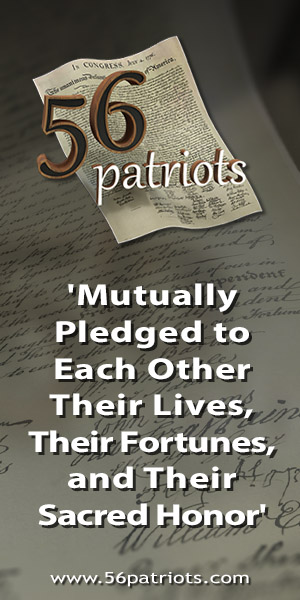Stewards of the Visual Exposition
RELIGIOUS LIBERTY: Why Such Hostility to This Fundamental Freedom?
In this excerpt from the Opinion, he explains: "Petitioners (atheists) contend that the state laws requiring or permitting use of the Regents' prayer must be struck down as a violation of the Establishment Clause because that prayer was composed by governmental officials as a part of a governmental program to further religious beliefs. For this reason, they argue, the State's use of the Regents' prayer in its public school system breaches the constitutional wall of separation between Church and State. We agree. We think that the constitutional prohibition against laws respecting an establishment of religion must at least mean that in this country it is no part of the business of government to compose official prayers for any group of the American people to recite as a part of a religious program carried on by government."
Furthermore, he wrote:
"The wholesome "neutrality" of government toward religion of which this Court's cases speak . . . stems from a recognition of the teachings of history that powerful sects or groups might bring about a fusion of governmental and religious functions or a concert or dependency of one upon the other to the end that official support of the State or Federal Government would be placed behind the tenets of one or of all orthodoxies. This the Establishment Clause prohibits. And a further reason for neutrality is found in the Free Exercise Clause, which recognizes the value of religious training, teaching and observance and, more particularly, the right of every person to freely choose his own course with reference thereto, free of any compulsion from the state. This the Free Exercise Clause guarantees. Thus, the two clauses may overlap.... The test may be stated as follows: what are the purpose and the primary effect of the enactment? If either is the advancement or inhibition of religion, then the enactment exceeds the scope of legislative power as circumscribed by the Constitution.... T]here must be a secular legislative purpose and a primary effect that neither advances nor inhibits religion. The Free Exercise Clause withdraws from legislative power, state and federal, the exertion of any restraint on the free exercise of religion. Its purpose is to secure religious liberty in the individual by prohibiting any invasions thereof by civil authority. Hence it is necessary in a free exercise case for one to show the coercive effect of the enactment as it operates against him in the practice of his religion. The distinction between the two clauses is apparent-a violation of the Free Exercise Clause is predicated on coercion while the Establishment Clause violation need not be so attended.
Applying the Establishment Clause principles to the cases at bar, we find that reciting morning readings from the Bible and recitation of the Lord's Prayer constitute a religious ceremony that was intended by the State to be so. Given that finding, the exercises and the law requiring them are in violation of the Establishment Clause.
The State contends that the program is an effort to extend its benefits to all public-school children without regard to their religious belief. Included within its secular purposes, it says, are the promotion of moral values, the contradiction to the materialistic trends of our times, the perpetuation of our institutions and the teaching of literature. The short answer is that the religious character of the exercise was admitted by the State. But even if its purpose is not strictly religious, it is sought to be accomplished through readings, without comment, from the Bible. Surely the place of the Bible as an instrument of religion cannot be gainsaid, and the State's recognition of the pervading religious character of the ceremony is evident from the rule's specific permission permitting nonattendance at the exercises. None of these factors is consistent with the contention that the Bible is here used either as an instrument for nonreligious moral inspiration or as a reference for the teaching of secular subjects.
The conclusion follows that, in both cases, the laws require religious exercises, and such exercises are being conducted in direct violation of the rights of the appellees and petitioners. Nor are these required exercises mitigated by the fact that individual students may absent themselves upon parental request, for that fact furnishes no defense to a claim of unconstitutionality under the Establishment Clause. Further, it is no defense to urge that the religious practices here may be relatively minor encroachments on the First Amendment. The breach of neutrality that is today a trickling stream may all too soon become a raging torrent and, in the words of James Madison, "it is proper to take alarm at the first experiment on our liberties" (Memorial and Remonstrance Against Religious Assessments).
It is insisted that, unless these religious exercises are permitted, a 'religion of secularism' is established in the schools. We agree, of course, that the State may not establish a 'religion of secularism' in the sense of affirmatively opposing or showing hostility to religion, thus 'preferring those who believe in no religion over those who do believe' (Zorach v. Clauson). We do not agree, however, that this decision in any sense has that effect. In addition, it might well be said that one's education is not complete without a study of comparative religion or the history of religion and its relationship to the advancement of civilization. It certainly may be said that the Bible is worthy of study for its literary and historic qualities. Nothing we have said here indicates that such study of the Bible or of religion, when presented objectively as part of a secular program of education, may not be effected consistently with the First Amendment. But the exercises here do not fall into those categories. They are religious exercises, required by the States in violation of the command of the First Amendment that the Government maintain strict neutrality, neither aiding nor opposing religion.
Finally, we cannot accept that the concept of neutrality, which does not permit a State to require a religious exercise even with the consent of the majority of those affected, collides with the majority's right to free exercise of religion. While the Free Exercise Clause clearly prohibits the use of state action to deny the rights of free exercise to anyone, it has never meant that a majority could use the machinery of the State to practice its beliefs....
The place of religion in our society is an exalted one, achieved through a long tradition of reliance on the home, the church and the inviolable citadel of the individual heart and mind. We have come to recognize through bitter experience that it is not within the power of government to invade that citadel, whether its purpose or effect be to aid or oppose, to advance or retard. In the relationship between man and religion, the State is firmly committed to a position of neutrality. Though the application of that rule requires interpretation of a delicate sort, the rule itself is clearly and concisely stated in the words of the First Amendment. Applying that rule to the facts of these cases, we affirm the judgment...."
Justice Douglas wrote, in his concurring opinion:
"The Establishment Clause is not limited to precluding the State itself from conducting religious exercises. It also forbids the State to employ its facilities or funds in a way that gives any church, or all churches, greater strength in our society than it would have by relying on its members alone. Thus, the present regimes must fall under that clause for the additional reason that public funds, though small in amount, are being used to promote a religious exercise. Through the mechanism of the State, all of the people are being required to finance a religious exercise that only some of the people want and that violates the sensibilities of others.
The most effective way to establish any institution is to finance it, and this truth is reflected in the appeals by church groups for public funds to finance their religious schools. Financing a church either in its strictly religious activities or in its other activities is equally unconstitutional, as I understand the Establishment Clause. Budgets for one activity may be technically separable from budgets for others. But the institution is an inseparable whole, a living organism, which is strengthened in proselytizing when it is strengthened in any department by contributions from other than its own members.
Such contributions may not be made by the State even in a minor degree without violating the Establishment Clause. It is not the amount of public funds expended; as this case illustrates, it is the use to which public funds are put that is controlling. For the First Amendment does not say that some forms of establishment are allowed; it says that "no law respecting an establishment of religion" shall be made. What may not be done directly may not be done indirectly, lest the Establishment Clause become a mockery."
It should be acknowledged that the cases before the high Court were intentionally brought by atheist and other anti-religion persons and organizations for the sole purpose of taking religion out of our public schools. Next would come the demonization of the Ten Commandments and the Golden Rule.
One of the most notorious atheist activists was Madalyn Murray O'Hair, a proud and avowed atheist and hedonist. Murray was born in Pittsburgh, Pennsylvania in 1919. Pregnant with her first child in 1945, she declared to her family that she was going outside to "challenge God to strike me and this child dead with one of those lightning bolts." She took pleasure in the fact that she was not struck down, despite violently cursing and bating God. This event set a precedent for numerous dramatic and attention-seeking decisions she would make later in her life, nearly all of which were facilitated by her abhorrence of religion.
It was the deeply rooted educational practice of reading the Bible in class that Murray set her sights on. She was determined to have the practice prohibited. Murray herself most clearly spelled out her beliefs and aims in a letter to her supporters: "We are Atheists. As such, we are foes of any and all religions. We want the Bible out of school because we do not accept it as being either holy or an accurate historical document. We want the Lord's prayer out of school because we doubt the historicity of Jesus Christ and also we do not believe in the efficacy of prayer." In 1963, she brought a case, Murray v. Curlett, challenging the policy of mandatory prayers and Bible reading in Baltimore public schools. The case was consolidated with the Abington case for hearing by the Supreme Court.
Murray publicized her victory as a triumph against the oppressive hegemony of the church in Christian society. Unsurprisingly, she achieved celebrity status, though much of the attention was violently antagonistic. Life Magazine would later describe Murray as "The Most Hated Woman in America," a title which she relished.
It is perhaps a shame that she is remembered most due to the nature of her death. In August 1977, Murray, her son and her granddaughter all disappeared from their home in Austin, Texas. It would be weeks before the police discovered their brutally deformed remains in a nearby ranch. She worked hard to make sure we ushered in an era of hostility to religion. She was a vile woman who met a grisly end. She will continue to be remembered as the "Most Hated Woman in America."
The Supreme Court remained on course, validating the hostility to religion in public schools. For example, in the 1990 case of Stone v. Graham, the Supreme Court was asked to address a challenge by Sydell Stone and a number of other parents who claimed that a Kentucky state law that required the posting of a copy of the Ten Commandments in each public-school classroom was unconstitutional. They filed a claim against James Graham, the superintendent of public schools in Kentucky.
The question brought before the Court was whether the Kentucky statute violated the Establishment Clause of the First Amendment? The Supreme Court ruled that because of the new interpretation of "separation of church and state," it was unconstitutional for a student at school to continue, even voluntarily, to see a copy of the Ten Commandments. The Court explained: "If the posted copies of the Ten Commandments are to have any effect at all, it will be to induce the school children to read, meditate upon."
With the Reynolds opinion,the Supreme Court reversed more than two centuries of precedent (including its own previous rulings), ordering that the Bible and its teachings are no longer to be permitted in public schools. Why? The Court explained: "If portions of the New Testament were read without explanation, they could be and.... had been psychologically harmful to the child (student)."
According to the Court, if students, even voluntarily, were to look at a copy of the Ten Commandments, they might adopt and even obey teachings such as "do not steal" and "do not kill." That would be unconstitutional. Horrors!! This bizarre and unreasonable logic is reflective of far too many of the Court's rulings on religion and religious liberty since 1962, with the Engel v. Vitale decision, and then 1963, with the Abington v. Schempp decision, as explained above.
What an amazing pronouncement from the Supreme Court - the Scriptures can cause psychological damage. Exposing students to Biblical teachings, such as the Golden Rule, the Beatitudes, and the Good Samaritan, can cause lasting brain damage! Who could imagine that the highest court in the land, tasked with interpreting the US Constitution, as originally written and understood, and as adopted and ratified by the States, would so recklessly and erroneously transform our American public school system.
But the Supreme Court seems poised to make things right again. Take, for example, this year's case, Kennedy v. Bremerton School District. Joseph Kennedy, a high school football coach, engaged in prayer with a number of students during and after school games. He especially prayed in gratitude at the 50-yard line after each game his team won. His employer, the Bremerton School District, asked that he discontinue the practice in order to protect the school from a lawsuit based on violation of the Establishment Clause, but coach Kennedy refused and instead rallied local and national television, print media, and social media to support him.
Kennedy sued the school district for violating his rights under the First Amendment and Title VII of the Civil Rights Act of 1964. The district court held that because the school district suspended him solely because of the risk of constitutional liability associated with his religious conduct, its actions were justified. Kennedy appealed, but the U.S. Court of Appeals for the Ninth Circuit affirmed the decision of the lower court. Kennedy then appealed his case to the Supreme Court.
The issue presented to the Court was whether a public-school employee's prayer during school sports activities constitutes protected speech, and if so, can the public-school employer prohibit it to avoid violating the Establishment Clause?
Writing for the majority, Justice Neil Gorsuch explained that the Free Exercise and Free Speech Clauses of the First Amendment protect an individual engaging in a personal religious observance from government reprisal and the Constitution neither mandates nor permits the government to suppress such religious expression.
In fact, the Court "abandoned" the "tests" used to analyze First Amendment religious liberty cases and replaced them instead with an analysis that considers "historical practices and understandings." Applying the new test, the Court concluded that there is no conflict between the constitutional commands of the First Amendment presented by coach Kennedy's actions.
Go Back
Furthermore, he wrote:
"The wholesome "neutrality" of government toward religion of which this Court's cases speak . . . stems from a recognition of the teachings of history that powerful sects or groups might bring about a fusion of governmental and religious functions or a concert or dependency of one upon the other to the end that official support of the State or Federal Government would be placed behind the tenets of one or of all orthodoxies. This the Establishment Clause prohibits. And a further reason for neutrality is found in the Free Exercise Clause, which recognizes the value of religious training, teaching and observance and, more particularly, the right of every person to freely choose his own course with reference thereto, free of any compulsion from the state. This the Free Exercise Clause guarantees. Thus, the two clauses may overlap.... The test may be stated as follows: what are the purpose and the primary effect of the enactment? If either is the advancement or inhibition of religion, then the enactment exceeds the scope of legislative power as circumscribed by the Constitution.... T]here must be a secular legislative purpose and a primary effect that neither advances nor inhibits religion. The Free Exercise Clause withdraws from legislative power, state and federal, the exertion of any restraint on the free exercise of religion. Its purpose is to secure religious liberty in the individual by prohibiting any invasions thereof by civil authority. Hence it is necessary in a free exercise case for one to show the coercive effect of the enactment as it operates against him in the practice of his religion. The distinction between the two clauses is apparent-a violation of the Free Exercise Clause is predicated on coercion while the Establishment Clause violation need not be so attended.
Applying the Establishment Clause principles to the cases at bar, we find that reciting morning readings from the Bible and recitation of the Lord's Prayer constitute a religious ceremony that was intended by the State to be so. Given that finding, the exercises and the law requiring them are in violation of the Establishment Clause.
The State contends that the program is an effort to extend its benefits to all public-school children without regard to their religious belief. Included within its secular purposes, it says, are the promotion of moral values, the contradiction to the materialistic trends of our times, the perpetuation of our institutions and the teaching of literature. The short answer is that the religious character of the exercise was admitted by the State. But even if its purpose is not strictly religious, it is sought to be accomplished through readings, without comment, from the Bible. Surely the place of the Bible as an instrument of religion cannot be gainsaid, and the State's recognition of the pervading religious character of the ceremony is evident from the rule's specific permission permitting nonattendance at the exercises. None of these factors is consistent with the contention that the Bible is here used either as an instrument for nonreligious moral inspiration or as a reference for the teaching of secular subjects.
The conclusion follows that, in both cases, the laws require religious exercises, and such exercises are being conducted in direct violation of the rights of the appellees and petitioners. Nor are these required exercises mitigated by the fact that individual students may absent themselves upon parental request, for that fact furnishes no defense to a claim of unconstitutionality under the Establishment Clause. Further, it is no defense to urge that the religious practices here may be relatively minor encroachments on the First Amendment. The breach of neutrality that is today a trickling stream may all too soon become a raging torrent and, in the words of James Madison, "it is proper to take alarm at the first experiment on our liberties" (Memorial and Remonstrance Against Religious Assessments).
It is insisted that, unless these religious exercises are permitted, a 'religion of secularism' is established in the schools. We agree, of course, that the State may not establish a 'religion of secularism' in the sense of affirmatively opposing or showing hostility to religion, thus 'preferring those who believe in no religion over those who do believe' (Zorach v. Clauson). We do not agree, however, that this decision in any sense has that effect. In addition, it might well be said that one's education is not complete without a study of comparative religion or the history of religion and its relationship to the advancement of civilization. It certainly may be said that the Bible is worthy of study for its literary and historic qualities. Nothing we have said here indicates that such study of the Bible or of religion, when presented objectively as part of a secular program of education, may not be effected consistently with the First Amendment. But the exercises here do not fall into those categories. They are religious exercises, required by the States in violation of the command of the First Amendment that the Government maintain strict neutrality, neither aiding nor opposing religion.
Finally, we cannot accept that the concept of neutrality, which does not permit a State to require a religious exercise even with the consent of the majority of those affected, collides with the majority's right to free exercise of religion. While the Free Exercise Clause clearly prohibits the use of state action to deny the rights of free exercise to anyone, it has never meant that a majority could use the machinery of the State to practice its beliefs....
The place of religion in our society is an exalted one, achieved through a long tradition of reliance on the home, the church and the inviolable citadel of the individual heart and mind. We have come to recognize through bitter experience that it is not within the power of government to invade that citadel, whether its purpose or effect be to aid or oppose, to advance or retard. In the relationship between man and religion, the State is firmly committed to a position of neutrality. Though the application of that rule requires interpretation of a delicate sort, the rule itself is clearly and concisely stated in the words of the First Amendment. Applying that rule to the facts of these cases, we affirm the judgment...."
Justice Douglas wrote, in his concurring opinion:
"The Establishment Clause is not limited to precluding the State itself from conducting religious exercises. It also forbids the State to employ its facilities or funds in a way that gives any church, or all churches, greater strength in our society than it would have by relying on its members alone. Thus, the present regimes must fall under that clause for the additional reason that public funds, though small in amount, are being used to promote a religious exercise. Through the mechanism of the State, all of the people are being required to finance a religious exercise that only some of the people want and that violates the sensibilities of others.
The most effective way to establish any institution is to finance it, and this truth is reflected in the appeals by church groups for public funds to finance their religious schools. Financing a church either in its strictly religious activities or in its other activities is equally unconstitutional, as I understand the Establishment Clause. Budgets for one activity may be technically separable from budgets for others. But the institution is an inseparable whole, a living organism, which is strengthened in proselytizing when it is strengthened in any department by contributions from other than its own members.
Such contributions may not be made by the State even in a minor degree without violating the Establishment Clause. It is not the amount of public funds expended; as this case illustrates, it is the use to which public funds are put that is controlling. For the First Amendment does not say that some forms of establishment are allowed; it says that "no law respecting an establishment of religion" shall be made. What may not be done directly may not be done indirectly, lest the Establishment Clause become a mockery."
It should be acknowledged that the cases before the high Court were intentionally brought by atheist and other anti-religion persons and organizations for the sole purpose of taking religion out of our public schools. Next would come the demonization of the Ten Commandments and the Golden Rule.
One of the most notorious atheist activists was Madalyn Murray O'Hair, a proud and avowed atheist and hedonist. Murray was born in Pittsburgh, Pennsylvania in 1919. Pregnant with her first child in 1945, she declared to her family that she was going outside to "challenge God to strike me and this child dead with one of those lightning bolts." She took pleasure in the fact that she was not struck down, despite violently cursing and bating God. This event set a precedent for numerous dramatic and attention-seeking decisions she would make later in her life, nearly all of which were facilitated by her abhorrence of religion.
It was the deeply rooted educational practice of reading the Bible in class that Murray set her sights on. She was determined to have the practice prohibited. Murray herself most clearly spelled out her beliefs and aims in a letter to her supporters: "We are Atheists. As such, we are foes of any and all religions. We want the Bible out of school because we do not accept it as being either holy or an accurate historical document. We want the Lord's prayer out of school because we doubt the historicity of Jesus Christ and also we do not believe in the efficacy of prayer." In 1963, she brought a case, Murray v. Curlett, challenging the policy of mandatory prayers and Bible reading in Baltimore public schools. The case was consolidated with the Abington case for hearing by the Supreme Court.
Murray publicized her victory as a triumph against the oppressive hegemony of the church in Christian society. Unsurprisingly, she achieved celebrity status, though much of the attention was violently antagonistic. Life Magazine would later describe Murray as "The Most Hated Woman in America," a title which she relished.
It is perhaps a shame that she is remembered most due to the nature of her death. In August 1977, Murray, her son and her granddaughter all disappeared from their home in Austin, Texas. It would be weeks before the police discovered their brutally deformed remains in a nearby ranch. She worked hard to make sure we ushered in an era of hostility to religion. She was a vile woman who met a grisly end. She will continue to be remembered as the "Most Hated Woman in America."
The Supreme Court remained on course, validating the hostility to religion in public schools. For example, in the 1990 case of Stone v. Graham, the Supreme Court was asked to address a challenge by Sydell Stone and a number of other parents who claimed that a Kentucky state law that required the posting of a copy of the Ten Commandments in each public-school classroom was unconstitutional. They filed a claim against James Graham, the superintendent of public schools in Kentucky.
The question brought before the Court was whether the Kentucky statute violated the Establishment Clause of the First Amendment? The Supreme Court ruled that because of the new interpretation of "separation of church and state," it was unconstitutional for a student at school to continue, even voluntarily, to see a copy of the Ten Commandments. The Court explained: "If the posted copies of the Ten Commandments are to have any effect at all, it will be to induce the school children to read, meditate upon."
With the Reynolds opinion,the Supreme Court reversed more than two centuries of precedent (including its own previous rulings), ordering that the Bible and its teachings are no longer to be permitted in public schools. Why? The Court explained: "If portions of the New Testament were read without explanation, they could be and.... had been psychologically harmful to the child (student)."
According to the Court, if students, even voluntarily, were to look at a copy of the Ten Commandments, they might adopt and even obey teachings such as "do not steal" and "do not kill." That would be unconstitutional. Horrors!! This bizarre and unreasonable logic is reflective of far too many of the Court's rulings on religion and religious liberty since 1962, with the Engel v. Vitale decision, and then 1963, with the Abington v. Schempp decision, as explained above.
What an amazing pronouncement from the Supreme Court - the Scriptures can cause psychological damage. Exposing students to Biblical teachings, such as the Golden Rule, the Beatitudes, and the Good Samaritan, can cause lasting brain damage! Who could imagine that the highest court in the land, tasked with interpreting the US Constitution, as originally written and understood, and as adopted and ratified by the States, would so recklessly and erroneously transform our American public school system.
But the Supreme Court seems poised to make things right again. Take, for example, this year's case, Kennedy v. Bremerton School District. Joseph Kennedy, a high school football coach, engaged in prayer with a number of students during and after school games. He especially prayed in gratitude at the 50-yard line after each game his team won. His employer, the Bremerton School District, asked that he discontinue the practice in order to protect the school from a lawsuit based on violation of the Establishment Clause, but coach Kennedy refused and instead rallied local and national television, print media, and social media to support him.
Kennedy sued the school district for violating his rights under the First Amendment and Title VII of the Civil Rights Act of 1964. The district court held that because the school district suspended him solely because of the risk of constitutional liability associated with his religious conduct, its actions were justified. Kennedy appealed, but the U.S. Court of Appeals for the Ninth Circuit affirmed the decision of the lower court. Kennedy then appealed his case to the Supreme Court.
The issue presented to the Court was whether a public-school employee's prayer during school sports activities constitutes protected speech, and if so, can the public-school employer prohibit it to avoid violating the Establishment Clause?
Writing for the majority, Justice Neil Gorsuch explained that the Free Exercise and Free Speech Clauses of the First Amendment protect an individual engaging in a personal religious observance from government reprisal and the Constitution neither mandates nor permits the government to suppress such religious expression.
In fact, the Court "abandoned" the "tests" used to analyze First Amendment religious liberty cases and replaced them instead with an analysis that considers "historical practices and understandings." Applying the new test, the Court concluded that there is no conflict between the constitutional commands of the First Amendment presented by coach Kennedy's actions.
























